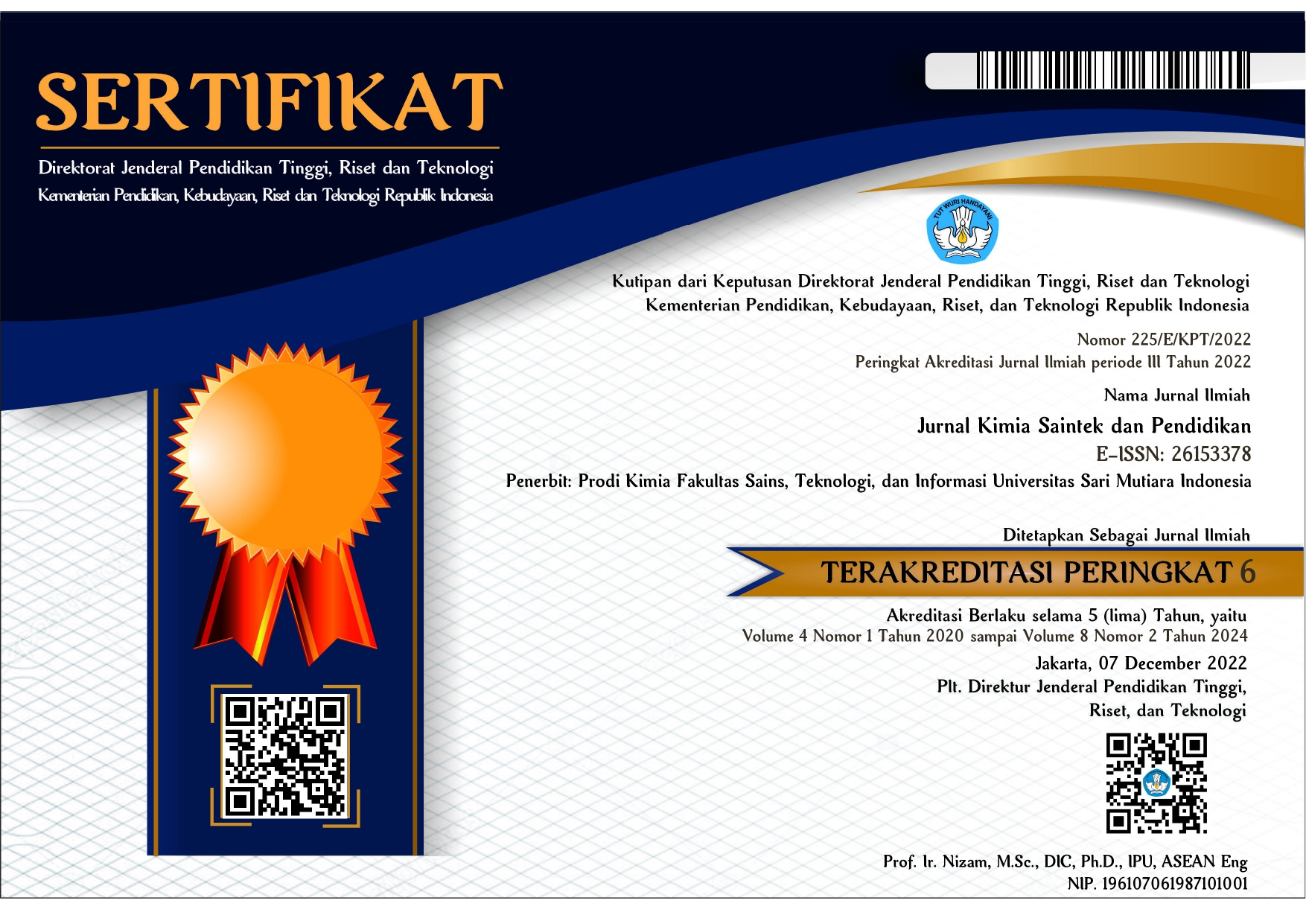PENGOLAHAN LIMBAH KULIT KAKAO DAN KEMIRI PADA PEMBUATAN BIOPELET SEBAGAI BAHAN BAKAR ALTERNATIF
DOI:
https://doi.org/10.51544/kimia.v6i2.3492Keywords:
Biopellet, renewable alternative fuel, Waste Treatment, Cocoa, Candlenut, Calorific ValueAbstract
The amount of fuel reserves were getting depleted and has created problems with the occurrence of a fuel crisis, which has resulted in higher prices and the economy of the community has been down. Biomass is a renewable alternative fuel source but still has weaknesses, like high water content, low calorific value and low density and the combustion process requires high temperatures. To overcome this problem, biomass can be processed into biopellets with the aim of increasing its density and increasing the quality of combustion. The research was about the processing of cocoa and candlenut shell waste as an alternative fuel in the manufacture of biopellets using tapioca adhesive. The stages of this research include the preparation of raw materials for cocoa shells and candlenut shells ground to a size of 60 mesh and then added with various adhesives of 5%, 10% and 15%, then printed manually and dried in an oven with a temperature of 60oC for ±3 hours. Furthermore, the biopellets were characterized based on the provisions of SNI 8021:2014 which included density, moisture content, ash content, volatile matter, fixed carbon, calorific value with the most optimum values, respectively, 1.02 g/cm3, 3.14%, 6 ,25%, 64.56%, 26.05% and 4145.6 cal/g. Biopellets were also tested for effectiveness such as fracture strength and combustion rates with values of 0.14% and 0.11 g/min, respectively. Biopellet with the best quality was found in the type of biopellet with a mixture of raw materials 2:1 and using 10% tapioca adhesive.
Downloads
References
Abimanyu, Haznan, dan Sunit Hendrana. 2018. Konversi Biomassa untuk Energi Alternatif di Indonesia : Tinjauan Sumber.
Ahmad Zikri, Fatria, Alexander Zulkarnain, Dicky Syahputra. 2019. “Analisa Unjuk Kerja Kompor Biomassa Terhadap Karakteristik Biopelet Eceng Gondok ( Eichhornia crassipes ) Dengan Getah Damar ( Agathis loranthifolia )” 10 (03): 1–5.
Arhamsyah. 2006. “Pemanfaatan biomassa kayu sebagai sumber energi terbarukan.”
D Dhuha Lamanda, Dina Setyawati, Nurhaida, Farah Diba, Emi Roslinda. 2015. “Karakteristik Biopelet Berdasarkan Komposisi Serbuk Batang Kelapa Sawit dan Arang Kayu Laban Dengan Jenis Perekat Sebagai Bahan Bakar Alternatif Terbarukan” 3: 313–21.
Djeni Hendra, Saptadi Darmawan. 2004. “Pembuatan briket arang dari serbuk gergaji kayu pinus dengan penambahan tempurung kelapa.” Jurnal Redoks.
Farikha. 2010. “Hidrolisis enzimatis pod kakao.” skripsi,.
Gandhi, Anshul, Varun Gupta, Mor Harchol-Balter, dan Michael A. Kozuch. 2010. “Optimality analysis of energy-performance trade-off for server farm management.” Performance Evaluation 67(11):1155–71. https://doi.org/10.1016/j.peva.2010.08. 009.
Hermiati. 2017. “Pemanfaatan biomassa lignoselulosa ampas tebu untuk produksi bioetanol.” Jurnal Penelitian dan Pengembangan Pertanian 29 (4):121–30. https://doi.org/10.21082/jp3.v29n4.201 0.p121-130.
Kaliyan, Nalladurai, dan R. Vance Morey. 2009. “Factors affecting strength and durability of densified biomass products.” Biomass and Bioenergy 33 (3): 337–59. https://doi.org/10.1016/j.biombioe.200 8.08.005.
Khaidir. 2016. “Pengolahan limbah pertanian sebagai bahan bakar alternatif.” Jurnal Agrium 13 (2): 63–68.
Laos, Landiana Etni, Mahardika Prasetya Aji, dan Sulhadi Sulhadi. 2016. “Pengaruh Konsentrasi Karbon Aktif Kulit Kemiri Dan Aplikasinya Terhadap Penjernihan Limbah Cair Methylene Blue” V: SNF2016-MPS-141-SNF2016-MPS-144. https://doi.org/10.21009/0305020227.
Lukum Haris, Isa Ishak, Sihaloho Mangara. 2006. “Pemanfaatan Arang Briket Limbah Tongkol Jagung Sebagai Bahan Bakar Alternatif,” 1–220.
Downloads
Published
Issue
Section
License
Copyright (c) 2022 JURNAL KIMIA SAINTEK DAN PENDIDIKAN

This work is licensed under a Creative Commons Attribution-ShareAlike 4.0 International License.











.png)

